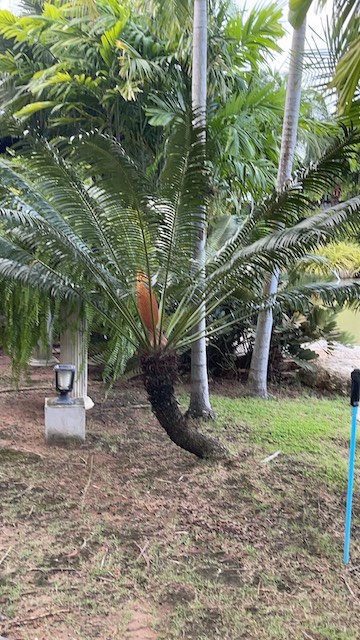Sciencetific Name: Cycas edentata
Family Name: CYCADACEAE
| Native Distribution | Andaman Islands, southern Myanmar, Thailand, southern Vietnam, Peninsular Malaysia, Singapore, Sumatra, Java, north Borneo, central and western Philippines. |
|---|
| Growth Form | It is a medium-sized palm-like plant with an emergent, usually unbranched trunk up to about 10 m tall. |
|---|
| Foliage | Its trunk bears rosettes of long, bright to deep green, feather-like leaves at its tip. Its stalked leaves are spiny, up to 2.3 m long, and consist of 100–200 glossy, stiff leathery, narrowly boat-shaped leaflets arranged neatly on either side of the leaf’s axis. |
|---|
| Reproductive Parts - non-flowering plant | The plant produces male or female trees. Instead of flowers, musky-scented cones grow at the tips of the tree trunk. The male trees produce cones that are compactly and regularly arranged, narrowly ovoid-cylindrical, orange-brown, and 30–60 by 11–14 cm. The male cones consist of microsporophylls that are 3.7–4.4 by 1.1–2.3 cm spirally arranged on a central axis. The microsporophylls have a distinct long, stout spine at the end, which differentiates it from the vegetatively similar looking Cycas rumphii. The female trees produce cones that are loosely arranged, and elongated. The female cones consist of megasporophylls that are covered with brown hairs, and 2–3 by 1.8–2.3 cm. Ovules, then seeds (if the ovules are fertilized) are found on the margins of the megasporophylls. |
|---|
| Habitat | It grows in sandy or rocky coastal vegetation, along shorelines in full or moderate shade. It occurs locally in Pulau Tekong. |
| Associated Fauna | Its strongly scented male cone is visited by insects that forage for pollen. It is also the preferred local food plant for caterpillars of the butterfly, the cycad blue (Chilades pandava pandava), that feeds on the immature shoots of the plant. |
| Cultivation | It is propagated by the suckers (that grow more quickly) or seed (which germinate slowly). |
| Etymology | Greek Cycas, name for a kind of palm, referring to the palm-like growth habit of this species; Latin edentata, without teeth, referring to the smooth margins of the female cone. |
| Ethnobotanical Uses | Edible Plant Parts : Edible Leaves, Edible Seeds
Food (Fruit or Vegetable)
Medicinal: The plant’s resin and seeds are applied to sores and malignant ulcers, respectively. Other parts of the plant are also used medicinally.
Others: A type of sago-like flour can be made from the trunks, and the unfurled leaves are said to be edible. The seeds are soaked in water for a few days, changing the water frequently during the process to leach out the poison (a toxic glucoside), and a kind of flour can be made from it. This plant is used as an ornamental. |
